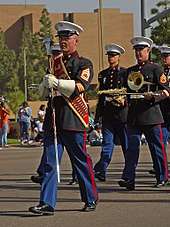Blood stripe
A blood stripe is a scarlet stripe worn down the outside leg seams of trousers on the dress uniform of the United States Marine Corps. This red stripe is 2 inches (5.1 cm) for general officers, 1 1⁄2 inches (3.8 cm) for other officers, and 1 1⁄8 inches (2.9 cm) for enlisted staff noncommissioned officers and non-commissioned officers. Modified versions are worn on the officers' evening dress uniforms, with the scarlet flanked with gold trim, and on members of the Marine Band, which wear the traditional red stripe with a white stripe in the center.

History
While trouser stripes were in use in various militaries for many years[1] (especially the British Army, whose uniforms influenced American uniforms for many years, as well as the red stripes of the Spanish Navy Marines), red trouser stripes were not a predominant feature of any American Marine uniform until 1837. In that year, President Andrew Jackson ordered changes that included the adoption of the Army's practice of wearing stripes the same color as uniform jacket facings.[1] These original stripes were buff white to match changes to the uniform jacket, but when the jacket was changed back to dark blue with red trim in 1839, the stripes remained, but altered to a similar blue edged in red. A U.S. Naval Institute history of USMC uniforms records that orders issued in January 1840 provided that officers and non commissioned officers were to wear a scarlet stripe down the outside seam of their blue trousers.[3]
Tradition holds that in the Battle of Chapultepec in Mexico on September 1847, Marine officers and NCOs sustained an unusually high casualty rate during the battle.[4] According to a Marine Corps publication, Marine casualties for the Mexico City campaign were 780 killed and 2,400 wounded, about fifty percent of the invading force. Ninety percent of Marine officers and non-commissioned officers who fought were killed.[5] Mexican snipers would strategically target officers and non-commissioned officers as they could be seen giving command motions to subordinates or some wore distinguishing uniform apparel, this dismantled combat effectiveness.
In 1849, uniform regulations dictated that the stripes be changed to a solid red in honor of the numerous Marine deaths. Ten years later, a scarlet cord was inserted into the outer seams for noncommissioned officers and musicians, while a scarlet welt was added for officers. Finally, in 1904, the simple scarlet stripe seen today was adopted, with the varying widths prescribed for different ranks.
See also
- Lampasse for military trouser-stripes in general.
- Leatherneck
- Eagle, Globe, and Anchor
- Uniforms of the United States Marine Corps
References
![]()
- Lore of the Corps Archived 2009-11-05 at the Wayback Machine by National Museum of the Marine Corps
- Col Robert H. Rankin USMC, Uniforms of the Sea Services, p145, United States Naval Institute 1962
- Kelly, Jack (April 12, 2009). "Kill the pirates". Pittsburgh Post-Gazette. Retrieved 2009-04-14.
- http://community.marines.mil/news/publications/Documents/Marines%20in%20the%20Mexican%20War%20%20PCN%2019000412200.pdf (link does not work)
Sources
- "Marine Corps Uniform Regulations". MCO P1020.34G W/CH 1-5. United States Marine Corps. 31 March 2003. Retrieved 2008-09-05.
- Dress Blues on marines.com
- Blood Stripe on Answers.com
- "Marine Corps Uniforms". Marine For Life. 3 September 2006. Archived from the original on 23 August 2009. Retrieved 2009-10-11.
- Leicht, Cpl. Paul W. (March 5, 2004). "Earning the Blood Stripe: Marines remember a legacy of sacrifice". Marine Corps Air Station Miramar: United States Marine Corps. Archived from the original on June 4, 2011. Retrieved 2009-10-11.
